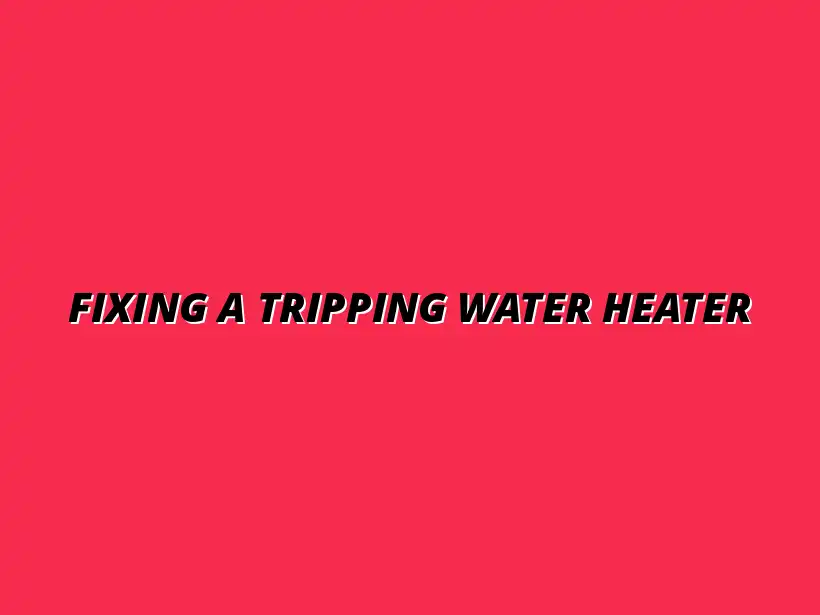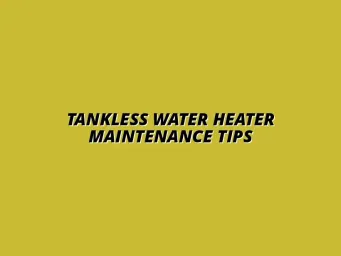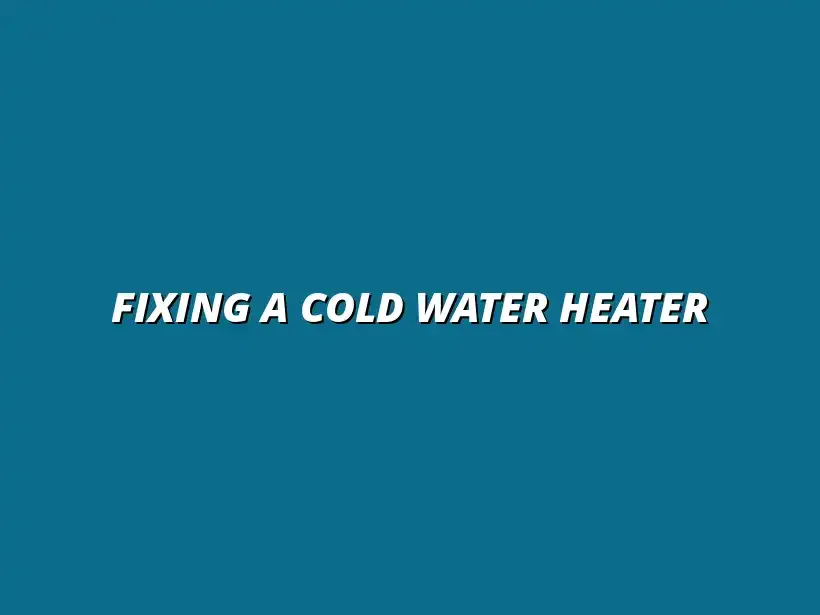
Fixing a Tripping Water Heater
Understanding the Problem: Water Heater Tripping the Thermostat
Have you ever experienced a situation where your water heater seems to be tripping the thermostat? It can be quite frustrating and concerning. Understanding the common causes of this problem will help you tackle it more effectively and ensure a warm shower every time!
Water heaters are essential for our daily routines, so when they malfunction, it can disrupt our lives. Often, the thermostat is the culprit behind the inconvenience. In this section, we will explore the reasons why your water heater might be tripping the thermostat, as well as important safety precautions before you start troubleshooting. If you're experiencing more widespread plumbing issues, you might find helpful advice on fixing a clogged kitchen sink or a leaky bathroom faucet.
Common Causes of a Water Heater Tripping the Thermostat
Several factors can lead to a water heater tripping the thermostat. Let's dive into some of the most common causes:
- Electrical Issues: Problems with wiring or circuit breakers can cause the thermostat to trip.
- Temperature Setting Problems: Incorrect temperature settings can lead to overheating, triggering the thermostat.
- Faulty Thermostat: A malfunctioning thermostat may not function properly, causing it to trip unexpectedly.
Electrical Issues Leading to Thermostat Tripping
Electrical problems are often the first thing to check when dealing with a tripped thermostat. Issues such as faulty wiring or a malfunctioning circuit breaker can disrupt the flow of electricity to the water heater. This disruption might cause the thermostat to trip as a safety measure.
It’s important to ensure that all wiring connections are secure and in good condition. If you notice any signs of wear or damage, it might be time to consult a professional for repairs. Keep in mind that a little attention to the electrical components can go a long way in maintaining a properly functioning water heater!
Temperature Setting Problems and Their Impact
The temperature setting on your water heater plays a crucial role in its performance. If it’s set too high, it can cause the water to overheat and the thermostat to trip. Generally, a safe temperature setting is around 120°F, which is warm enough for daily use without posing a risk of scalding. Learning how to test your water heater thermostat can be a valuable skill.
Regularly checking and adjusting the temperature settings can help prevent thermostat tripping. If you notice that the water is too hot, it may be time to dial it back! Keeping an eye on these settings is a simple yet effective way to maintain your water heater.
Faulty Thermostat: Signs and Symptoms
A faulty thermostat can be a sneaky issue that leads to repeated tripping. One of the telltale signs of a malfunctioning thermostat is inconsistency in water temperature. If you find that your water is frequently too hot or not hot enough, the thermostat might be the cause.
Other symptoms include strange noises coming from the water heater or frequent tripping of the circuit breaker. If you suspect your thermostat is the problem, it’s best to address it quickly to avoid further complications! Consider replacing it; learn more about how to replace your water heater thermostat.
Safety Precautions Before Troubleshooting
Before you start troubleshooting your water heater, it's crucial to prioritize safety. There are a few key precautions that can protect you during the process.
- Turn Off Power: Always turn off the power supply to the water heater before inspecting or making adjustments.
- Use Protective Gear: Wearing gloves and safety goggles can protect you from potential hazards.
- Ensure Proper Ventilation: If you're working in a closed area, make sure it's well-ventilated to avoid the build-up of harmful gases.
Importance of Turning Off Power
One of the most critical steps is to turn off the power to your water heater. This not only protects you from electrical shocks but also prevents further damage to the unit. Always make sure to switch off the circuit breaker or unplug the unit if it's an electric model.
Taking this precaution can save you from serious injuries and make the troubleshooting process much safer. Remember, safety first!
Using Protective Gear During Repairs
Using the right protective gear is essential when working on your water heater. Gloves will protect your hands from sharp edges, while safety goggles will shield your eyes from debris and splashes. It's important to dress appropriately for the task at hand!
By wearing protective gear, you can feel more confident while working on your water heater. It’s a small step that can make a big difference in keeping you safe during repairs!
Maintaining Your Water Heater for Optimal Performance
Keeping your water heater in good shape is essential for its longevity and efficiency. Regular maintenance will help you avoid problems like the thermostat tripping and ensure that your water heater operates smoothly. By following some simple practices, you can maintain your water heater and save money on repairs and energy bills! And don't forget about preventing frozen pipes during winter; check out these tips on how to prevent frozen pipes this winter.
In this section, I will outline the key maintenance tasks you should perform regularly. These practices will help you prevent future issues and keep your water heater running at its best. Let’s dive in!
Regular Maintenance Practices to Prevent Future Issues
One of the best ways to keep your water heater functioning well is through consistent maintenance. Here are some essential practices that can help you avoid issues:
- Flushing the Water Heater: This removes sediment buildup, improving efficiency.
- Checking Anode Rods: Inspecting these rods can prevent corrosion in your tank.
- Insulating Pipes: Insulating hot water pipes helps maintain temperature and saves energy.
- Testing Temperature and Pressure Relief Valve: This ensures safety and avoids excessive pressure build-up.
By performing these maintenance tasks regularly, you can ensure that your water heater works effectively. Remember, a little effort goes a long way in prolonging the life of your appliance!
Flushing the Water Heater: Benefits and Procedures
Flushing your water heater can significantly enhance its performance. This process removes sediment and mineral deposits that accumulate over time, leading to better heat transfer and energy efficiency. You may want to flush your heater at least once a year to keep it in top form.
To flush your water heater, follow these simple steps:
- Turn off the power supply or gas to the water heater.
- Connect a garden hose to the drain valve at the bottom of the tank.
- Open the drain valve and allow the water to flow out until clear.
- Close the valve, refill the tank, and turn the power back on.
Regularly flushing your water heater helps maintain its efficiency and prolongs its useful life!
Checking Anode Rods for Corrosion Prevention
The anode rod is a crucial component in preventing rust and corrosion in your water heater. It attracts corrosive elements, which helps to protect the tank itself. Checking the anode rod every few years can save you from costly replacements.
To check the anode rod, do the following:
- Turn off the water heater and shut off the cold water supply.
- Remove the top insulation cover and the anode rod's hex head.
- Inspect the rod for signs of corrosion or wear.
- If it’s less than ½ inch thick or heavily corroded, replace it.
Keeping an eye on the anode rod ensures your water heater remains in good shape and minimizes the risk of leaks!
Signs That Indicate It's Time for Replacement
Even with the best maintenance, there will come a time when your water heater needs replacing. Knowing the signs can save you from unexpected cold showers and repairs. Here are a few indicators that it might be time to consider a new unit:
- Age of the Water Heater: If it’s over 10-15 years old, it may be reaching the end of its lifespan.
- Inconsistent Water Temperature: If you experience fluctuating hot water, this may indicate a failing unit.
- Rusty Water: Brown or rusty water suggests the tank is corroding.
- Frequent Repairs: If you’re calling for repairs often, it may be more cost-effective to replace it.
Keeping an eye out for these signs can help you make informed decisions about your water heater! If you decide replacement is necessary, you might find this guide on fixing a water heater that won't start helpful, even though you are replacing the whole unit.
Recognizing Age and Efficiency Declines in Water Heaters
As water heaters age, their efficiency often declines. Many units lose their ability to heat water properly or can become less efficient in energy use. Regularly checking the age and performance of your heater is crucial to avoid unexpected issues.
Consider the following factors to assess age and efficiency:
- Check the manufacturer's label for the installation date.
- Monitor your energy bills for unusual spikes.
- Evaluate how long it takes to heat water compared to when it was new.
Being proactive about these checks helps you stay ahead of any potential problems!
Evaluating Repair Costs vs. Replacement Costs
When faced with a malfunctioning water heater, it’s essential to weigh the costs of repair against replacement. Sometimes, a simple fix might seem appealing, but if your unit is old or frequently needing repairs, replacing it could be more economical. For local plumbing help in Birmingham, consider checking out plumbers in Billesley, Birmingham.
Here are some key points to consider:
- Calculate the total cost of repairs over the past year.
- Research the price of a new water heater.
- Consider the potential energy savings of a newer model.
Comparing these costs can help you make a smart choice about your water heater!
Final Thoughts on Troubleshooting Water Heater Thermostat Issues
By understanding the maintenance practices for your water heater, you can prevent thermostat problems before they arise. Regular checks and upkeep will help keep your water heater running smoothly. Just remember, a little maintenance goes a long way in avoiding future headaches!
Summary of Key Steps for Fixing Thermostat Problems
In conclusion, fixing thermostat issues involves several key steps:
- Conduct initial checks for tripping issues.
- Test the thermostat with a multimeter.
- Replace faulty components as needed.
- Maintain regular maintenance to prevent future problems.
Keeping these steps in mind will help you effectively handle any thermostat issues that arise!
Encouragement to Stay Proactive About Water Heater Maintenance
It’s vital to stay proactive with your water heater’s maintenance! Regular attention to your unit will ensure efficient operation and reduce the chances of issues developing. I hope you feel empowered to take charge of your water heater and keep it in top-notch condition!




